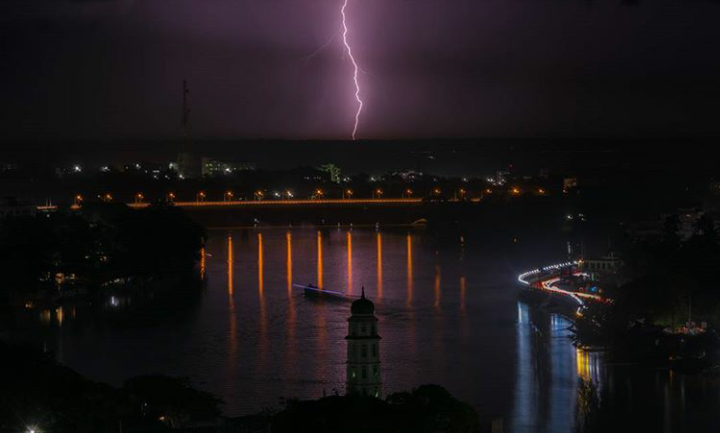Thunderstorm Photography Techniques

Reposting The Techniques of Thunderstorm.its really tough to capture a perfect shot of thunderstorm!At first,
Equipment:
For lightning photography to be successful at all, you will need:
SLR camera with B-shutter speed (preferably SLR; you might try using your digital camera, if it has B mode, but this is much more difficult)
lenses ranging from 28mm to 135mm at minimum. Fixed-focal lenses are preferred over zoomlenses. Aperture ranges should be f/2.8 - f/22.
sturdy tripod (metal or plastic doesn't make any difference whatsoever at all in safety - if lightning is so close by, you are in trouble anyway)
cable release, which can be locked
Slow-speed film: 100 or 200 ISO
The SLR should have a quicklink for tripod mounting, so that you can quickly setup the equipment. Thunderstorms can mature and die fast, and every minute usually counts.
Make sure all your lenses are very clean - no scratches, fingerprints or other imperfections. Lightning is so bright and so thin, that any imperfection will show readily on the photo. Also make sure you have lenses which you know don't have too much coma effect at low apertures - for lightning, any coma becomes readily visible.
Location
It is adviseable to search for a suitable location first, days before the first storm happens. Then you will know where to go, and you don't end up in potentially dangerous locations.
It doesn't matter much where to operate, but I recommend some place which stays dry during rain, under a roof or something, and is not too close to citylights (or cities in general). When you are out late at night in the dark, there may be drunk people driving by, so avoid the roads. Seek a small trail.
Choose a place at which the view to the sky is optimal. But most importantly, choose a location that is safe during lightning. Some situations you shouldn't be in when there are thunderstorms closer than about 10 km or so are:
being on a dike or hill, or on top of another tall object
being in the open field
being at or in a body of water
being near to trees
being near fences or powerline poles
being indoors and very close to a window
Taking a bath, or washing your hands (you risk an indirect hit)
Talking on the telephone (unless wireless/cellular
The Technique:
this is very simple, even though many people at first don't understand how anyone can be so fast in triggering the shutter release after seeing lightning. The trick is, you don't do that, because you will photograph lightning during the night (indeed daytime lightning photography is quite a challenge). You make use of the B shutter speed mode, which will leave the camera shutter open as long as you want, and you wait for lightning to occur in the frame.
The camera should be on a tripod, with a cable release: it should not move at all during the exposure, or the photo will be blurred
lightning photography is nothing more than setting up your equipment at night, setting focus to infinity, selecting the proper film speed and aperture, and open the shutter. Then wait for lightning, and when lightning occurs within your camera's view, you close the shutter (by unlocking the cable release) and advance the film for the next frame.
Complications arise, however, because you also have to deal with ambient light - light pollution, cloud movement and such - which will give your photos a look you may or may not want. The maximal exposure in cities is very limited, sometimes less than 30 seconds or so. If lightning is inactive, you'd spend a lot of film without lightning that way. Also, the correct exposure is still dependent on the film speed and aperture setting - it is the aperture setting which is one of the crucial factors determining the difference between good and mediocre photos. Another factor is composition.
Exposure
Sorry, I can't give you the correct exposure for lightning. But, since the duration of exposure is independent of lightning brightness (namely, you photograph at night using B shutter speed), and you will want to use 100 speed film for high resolution, your only concern is the correct aperture. Here are a few guidelines:
Lightning brightness Film ISO Aperture
Very close blinding CG lightning (< 100 m/yards) 100 ISO f/16-f/22
Relatively close, blinding CG lightning (~ 1 km) 100 ISO f/11
Distant CG lightning (5-10 km) 100 ISO f/5.6
Distant CC lightning (5-10 km) 100 ISO f/4
Distant CG/CC lightning (10-20 km) 200 ISO f/4-f/5.6
Remote CG/CC lightning (20-50 km) 200 ISO f/2.8
[Exposure guide for lightning photography. CG = cloud-to-ground, CC = cloud-to-cloud, IC = intracloud]
If lightning is very far away, say > 50 km, you will have to use a fast film, such as 400 ISO. Such lightning is in general not very spectacular to photograph, but you can practice anyway.
If you have lenses which show coma at low apertures, you will have to use a faster film and higher aperture. Coma can really ruin a photo.
http://www.weatherscapes.com/techniques.php?cat=lightning&page=lightning
One required technique that I lack with thunderstorm photography is WAIT.
Nice post!